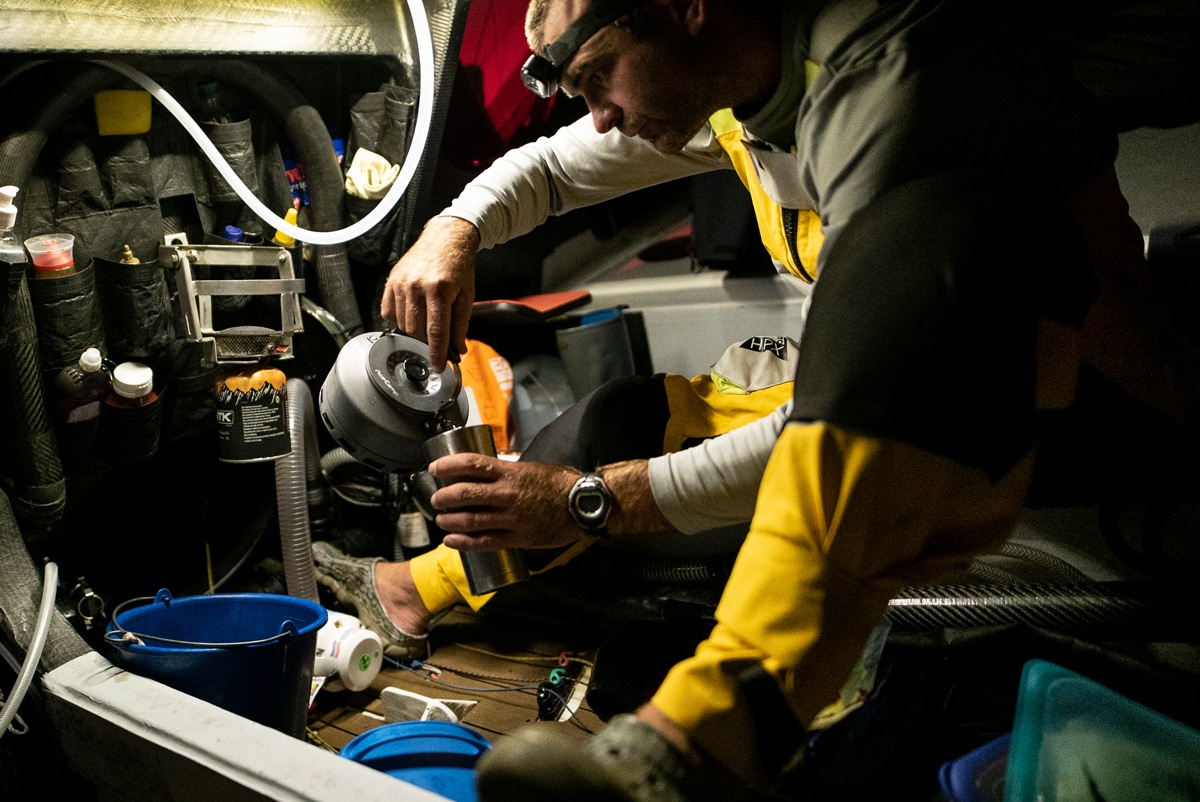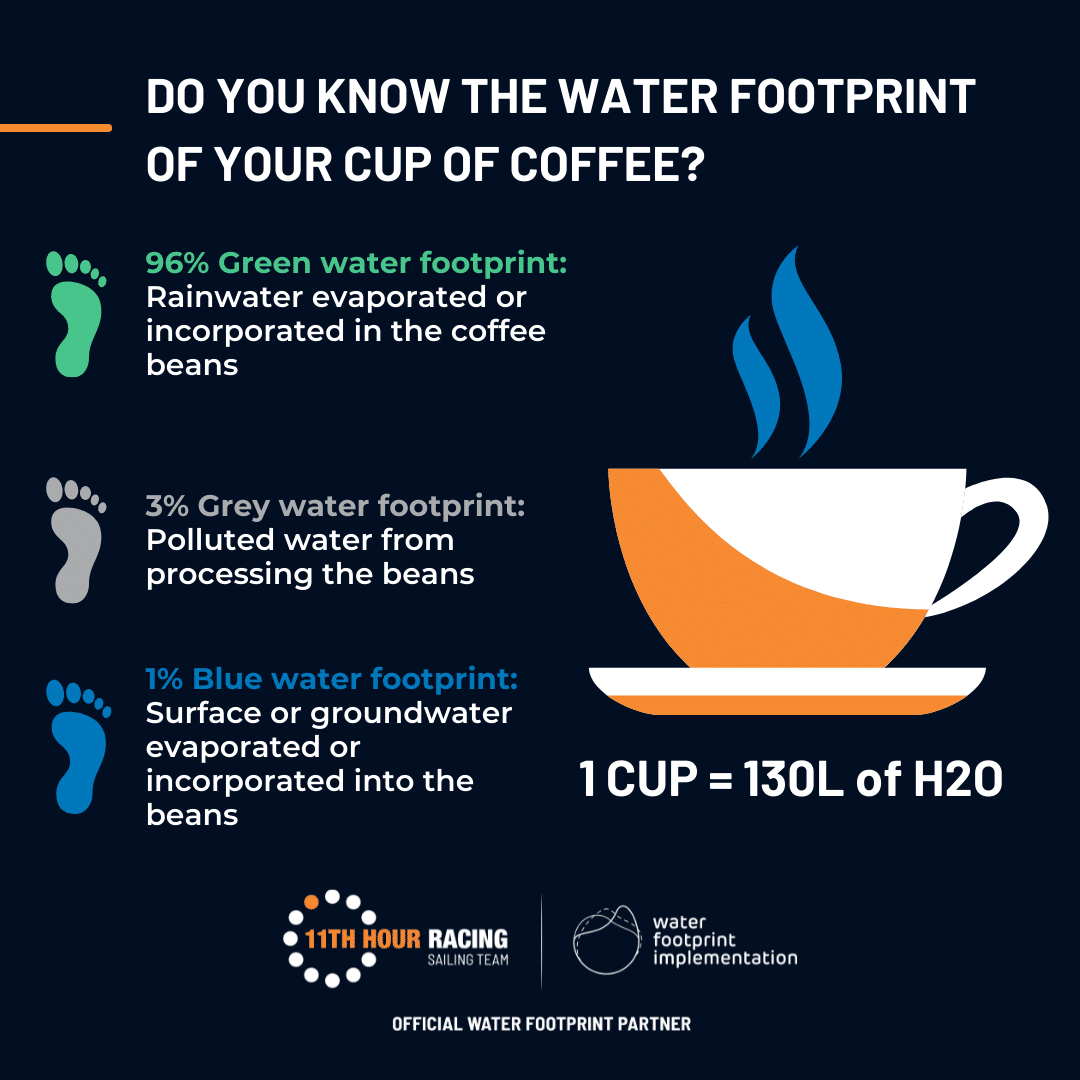How much water goes into one cup of coffee?
The Transat Jacques Vabre traditionally follows the ancient coffee route between Europe and South America. While the teams are racing in this edition from France to Martinique, where, no doubt, there is a large amount of coffee being drunk onboard, we thought we’d take a look at the coffee trade and its water footprint.
Who doesn’t love coffee? That instant energy boost and comforting warmth, the bitter-sweet taste and exotic feel. Not without reason, coffee has become one of the most popular beverages in the world, giving folks from Alaska to Africa a great reason to take a breather and soak in this black magic.
As with so many things brought to us by globalization, coffee doesn’t come without compromises though. While we don’t want to spoil the fun for anyone, like many we believe it’s important to consume things consciously and take into account the various resources needed to produce the goods we indulge.
Without water, there’s no coffee, that’s a given. But do you know how much water it really takes to make that double espresso in front of you?
To shed some light on this question, we spoke with somebody who knows more about water than most people on the planet: Ioana Dobrescu from Water Footprint Implementation.
The Hague-based knowledge organization has been helping our team since the end of 2020 to quantify our entire team’s water usage allowing us to make more conscious and environmentally-friendly decisions.
“It takes on average 140 liters to make one little cup of coffee,” explained Ioana when we met her at the Transat Jacques Vabre race village in Le Havre. “It is not just the physical water that goes into the cup but the water that goes into it right from the beginning of the supply chain, which starts with the growing of the coffee bean.”
Pretty much every product we consume has its own water footprint, which is essentially “a volumetric indicator of water consumption – the amount of water that it takes to produce any of the goods and services that we use,” explained Ioana.
140 liters for one cup of coffee helps account for the approximately 5,000 liters of water a person living in industrialized countries consumes every day. To fully understand where all that water comes from, take a look at this video below.
So how can we reduce our personal water footprint? Ioana recommended the following approach:
“As a consumer, the first thing you have to do is to inform yourself, even by simply searching ‘water footprint’ online and finding out what it really is. This can help you make better informed decisions and consciously choose products that involve a lower water consumption.”
Essentially, you can only manage what you can measure. Water Footprint Implementation provides an interactive tool to calculate your individual water footprint here.
Once you know where most of your water usage comes from, you can make significant tweaks to your lifestyle and consumption habits that don’t involve too much of a sacrifice. Which of these suggestions could you take on?
- Eat less and higher quality meat: On average, a healthy vegetarian diet uses up to 55% less water than an omnivorous diet. There are many delicious alternatives to meat and upping your fruit and veggie intake is never a bad idea (remember: five pieces of fruit and veg a day to keep the doctor away!).
If giving up meat is not an option, try to reduce consumption and go for quality over quantity: your steak will taste a lot better when you know the cow lived a dignified life before ending up on your plate. Industrially-produced meat is also to a much larger extent responsible for the mass-production of monoculture crops like irrigated corn, drawing heavily on the earth’s limited groundwater resources. Look for small local providers, ideally offering organic meat.
- Shop organic: Fertilizers and pesticides increase crop yields, but can be destructive for the environment, wildlife, and even harmful to the end consumer’s health. Organic farms use much less or zero harmful pesticides and fertilizers, and thus have less impact on the environment.
- What’s more, industrial agriculture decreases the soil’s water infiltration and retention capacity, requiring a larger amount of irrigation and, therefore, water consumption.
- Buy local products: Shortening supply chains is one of the easiest ways to cut down your water (and also carbon) footprint. The less distance your products have traveled, the more you can be reassured of making a sensible choice of purchase. On top of that, you are supporting your local community and can better avoid unnecessary packaging.
- Avoid food waste: Over 800 million people in the world suffer from chronic undernourishment, yet one-third of all food produced for human consumption goes to waste – enough to feed every under-nourished person across the globe, twice over! That also means that one-third of the water used to produce food is simply wasted.
We would always encourage you to avoid wasting food as much as you can – buy smaller quantities, use up leftovers, donate edible resources to people in need, freeze, and start composting. For more inspiration and hands-on tips, check out this article.
- Eat less refined foods: While whole foods like fruits and vegetables require water to grow, heavily processed foods utilize additional water for cleaning machinery and pre-cooking ingredients as well as in the production of fuel for delivery and packaging.This requires additional water usage and increases pollution. So eat fresh and get into the kitchen!
Check out Water Footprint Network to find more information on how to futureproof your lifestyle with a more considered consumption of water.
Institutions like Food Unfolded or the Food and Agriculture Organization of the UN also provide more insights on the bigger picture, such as the ethical aspects of agriculture, and pesticide usage.
And finally, even if it might be a bit of a sacrifice for a lot of us, why not swap one or the other cup of coffee for beverages that consume a little less water.
There are tasty alternatives like tea, juices, kombucha, home-made infusions… Playing by the principles of ‘less is more’, that one cup of high-quality, organic, and ideally fair-trade coffee might taste even better to you than ten supermarket ones. Enjoy!





